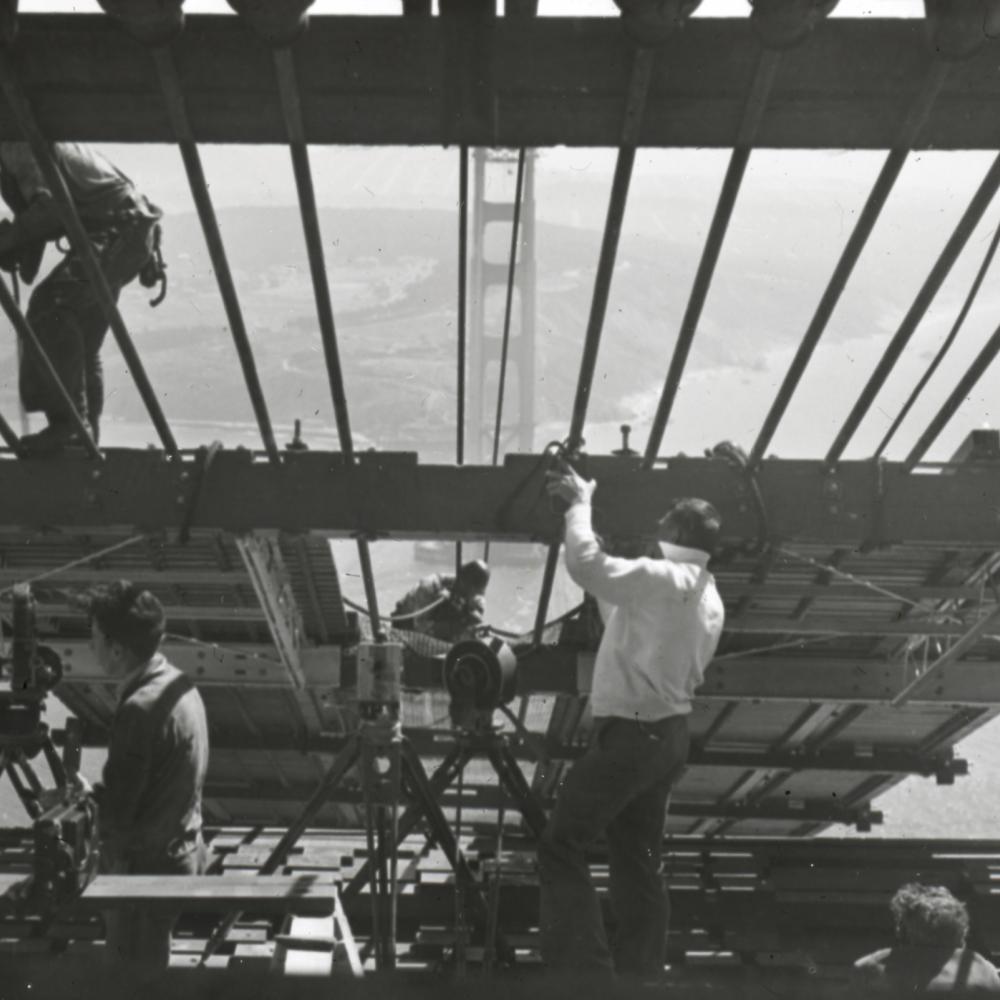The Golden Gate Bridge ceased long ago to have the world’s longest span. Its towers are far from the tallest among bridges. Its volume of traffic is not the highest. Its cost of about $35 million—raised by local bonds, not federal grants—ranks well behind that of its contemporary, the Hoover Dam, at $49 million. But it has a unique relationship with its city and its landscape, marking them as even the Statue of Liberty and the Empire State Building don’t define New York, or the Eiffel Tower Paris. It was not universally acclaimed at first; some local artists were convinced the structure would mar a magnificent landscape. Yet on its fiftieth anniversary in 1987, 250,000 people crowded onto its deck to celebrate.
One of the reasons for the Golden Gate’s enduring fame can be found not in California but in Roebling, a century-old former company town near Trenton, New Jersey, named for the maker of the bridge’s cables, John A. Roebling’s Sons. An exhibition at the Roebling Museum supported by the New Jersey Council for the Humanities, “Spinning Gold,” shows how the principles of the cable suspension bridge, developed by a German immigrant engineer in the 1840s and applied in the Brooklyn and George Washington bridges, met even greater challenges in 1937.
Roebling company engineers did not design the Golden Gate. The project was sparked by a brilliant but technically limited engineer, Joseph Strauss, who had made his name designing bascule river bridges in Chicago. His own original design was clumsy, but with the technical gifts of his academic associate, Charles Ellis, and of world-renowned consultants like Leon Moisseiff and O. H. Ammann, engineer of the George Washington Bridge, the result has been as strong as it is beautiful. Yet the success of the design depended on cables of unprecedented size.
John A. Roebling’s Sons, the successful bidders for making the bridge’s suspension cables, was a survivor of the consolidation of the steel industry around 1900. The Roebling mill had been built so the company would not depend on competitors for its raw material; steel smelted there was made into products from elevator ropes to window screens. Bidding on the Golden Gate, Roebling defeated U.S. Steel with a proposal of $5.9 million, which the exhibit estimates at about $97 million in today’s prices. For this it would have to deliver 80,000 miles of wire weighing 24,500 tons.
It was in the spinning of massive cable from strands of wire about a fifth of an inch thick that the Roebling family had become world famous. Two of the ideas of the founder, the immigrant German engineer John A. Roebling, incorporated in U.S. patents granted in 1846 and 1847, respectively, were the basis of suspension bridge construction. Giant cables could not be manufactured in sections at a factory and then spliced. They had to be made on the spot, spun by wheels traveling between bridge towers. This system, in turn, depended on creating an unbreakable bond between the cables and the earth. Roebling’s idea was to pass each strand of wire through steel loops in a structure of huge concrete weights called the anchorage, locking the already spun part of the cable down while the live end was passed in the other direction, to the opposing anchorage. At the Golden Gate, each anchorage was secured by 60,000 tons of concrete.
The contract was a godsend for the Roebling company. By 1932, it had laid off half its workers; with Golden Gate wire production in New Jersey, it had regained 2,000 jobs, plus 500 in California. But there was a risk. If the company missed contractual deadlines, it could lose money on the project. Under this pressure, Roebling engineers improved the traveling-wheel system. In a “split tram” system, two wheels approached each other from each side of the bridge, the wires were exchanged between them, and each wheel returned to its own side, doubling productivity. Ultimately, as many as six wheels with color-coded strands were deployed at once. Cable spinning took from October 1935 to May 1936, finishing months ahead of schedule.
Spinning was only the start. Workers on the spot had to compress the wires first into strands. The 27,572 wires were wrapped into sixty-one bundles. Dimensions of the bundles varied so that the cable would rest as compactly as possible in the saddles atop the towers. Workers used jacks exerting a pressure of 4,000 pounds per square inch to compress the finished cable into its final diameter of 36-3/8 inches, still the world’s thickest. A highlight of the exhibition is a section of this cable, still a marvel of the union of design, craftsmanship, and sheer force.
The Roebling family, unable to finance needed modernization after the Second World War, sold the company in 1953, and in 1973–1974 the new owners closed the plants. But the bridge’s legacy survived the corporation. A young engineer, Blair Birdsall, who worked for Roebling on the bridge’s construction, became a managing partner of one of the world’s leading civil engineering firms. At the time of his death, sixty years after completion of the Golden Gate, he was a consultant for the $5.8 billion Great Belt bridge and tunnel complex in Denmark, which has a main span 1,100 feet longer than the Golden Gate’s.
Why is the Golden Gate still more beloved than any other bridge in the world, according to surveys? It’s because, contrary to critics’ fears, it enhanced rather than defaced a magical site. Gifts from descendants of the owners and workers in the exhibition and museum show a pride that is undiminished after three-quarters of a century.


